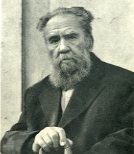
<p>140 years ago, architect Bohumil Hübschmann was born</p>
 |
Hübschmann, the son of a tailor, studied at the Prague School of Civil Engineering, gaining his first experience as an assistant to Jan Vejrych on the project for a museum in Chrudim and a school in Jilemnice. At the end of the 19th century, like many of his peers, he headed to the Vienna Academy, where he initially studied in Viktor Luntz's studio, but soon switched to Otto Wagner. Upon his return in 1905, he engaged in public debate about the shape of the Czech metropolis, becoming a member of the Mánes Society of Visual Artists and the Club for Old Prague.
He also actively transformed his hometown, with his early work notably including a duplex for the Jewish burial society Chevra Kadiša at the corner of Široká and Maislova streets (1911). A decade later, he also designed a building on Kaprova Street, where the famous Fischer bookstore was located until recently. He built several villas, including a house for Alphonse Mucha and his own residence in Střešovice, and also engaged in industrial projects (mills in Vysočany, Holešovice, and after the war in Hostivař, as well as a power plant in Ervěnice).
During the First Republic, Bohumil Hübschmann also focused on urbanism; in addition to the adjustments of the area under Emauzy, which he himself developed, he designed the regulation of the Petrská quarter together with Antonín Engel. He repeatedly participated in competitions for the completion of the Old Town Hall, first in 1899 and last 47 years later. His lifelong theme was the protection of the appearance of old Prague, which he devoted himself to significantly after World War II when he was a member of the State Institute for the Reconstruction of Monumental Towns. He died in November 1961.
The English translation is powered by AI tool. Switch to Czech to view the original text source.
0 comments
add comment






